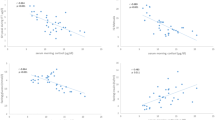Abstract
In 129 children, aged 12.6±3.8 years, affected by type 1 diabetes mellitus, the levels of dehydroepiandrosterone sulfate (DHEAS), cortisol, T3, fT3, T4, fT4, rT3, TSH, cholesterol, and triglycerides were evaluated and compared with those of a control group of 458 healthy age-matched children. The results were also correlated with hemoglobin HbA1C. The DHEAS-standard deviation score (DHEAS-SDS; −0.36±0.77) was significantly different from zero in diabetic children, while the cortisol serum level was higher than in control subjects (485±94 vs 359±132 nmol/l). Moreover, the DHEAS-SDS and DHEAS-SDS/cortisol ratio correlated negatively with HbA1c. Diabetic patients also showed lower T3 values (2.22 ± 0.4 vs 2.32±0.3 nmol/l) and a higher rT3/T3 ratio (0.17±0.09 vs 0.15±0.05) than controls. There was a negative correlation between T3 and HbA1C. Cholesterol (4.77±1.08 vs 4.51±0.76 mmol/l) and triglycerides (0.82 ±0.53 vs 0.63±0.37 g/L) levels were higher in diabetic children and positively correlated with HbA1c, but not with DHEAS-SDS. We can therefore conclude that diabetes, particularly if poorly controlled, tends to induce a dissociation of cortisol and DHEAS secretion and a low T3 syndrome, similar to that seen in other illnesses.
Similar content being viewed by others
References
Yen TY, Allan JA, Person DV, Acton JM, Prevention of obesity in Avy/a mice by dehydroepiandrosterone. Lipids 12: 409–413, 1977
Ben-David M, Dikstein S, Bismuth G, Sulman FG, Anti-hypercholesterolemic effect of dehydroepiandrosterone in rats. Proc Soc Exp Biol Med 125:1136–1140, 1967
Schwartz AG, Inhibition of spontaneous breast cancer formation in female C3H(Avy/a) mice by long-term treatment with dehydroepiandrosterone. Cancer Res 39:1129–1132, 1979
Coleman DL, Leiter EH, Schwizer RW, Therapeutic effect of dehydroepiandrosterone (DHEA) in diabetic mice. Diabetes 31:830–833, 1982
Nestler JE, Barlascini CO, Clore JN, Blackard WG, Dehydroepiandrosterone reduces serum low density lipoprotein levels and body fat but does not alter insulin sensitivity in normal men. J Clin Endocrinol Metab 66:57–61, 1988
Barrett-Connor E, Khaw K-T, Yen SSC, A prospective study of dehydroepiandrosterone sulfate, mortality and cardiovascular disease. N Engl J Med 315:1519–1524, 1986
Schriock ED, Buffington CK, Hubert GD, Kurt BR, Kitabchi AE, Buster JE, Givens GR, Divergent correlations of circulating dehydroepiandrosterone sulfate and testosterone with insulin levels and insulin receptor binding. J Clin Endocrinol Metab 66:1329–1331, 1988
Cohen HN, Paterson KR, Wallace AM, Beastall GH, Manderson WG, MacCuish AC, Dissociation of adrenarche and gonadarche in diabetes mellitus. Clin Endocrinol 20:717–724, 1984
Small M, Gray CE, Beastall GH, MacCuish AC, Adrenal androgens in insulin-dependent diabetes mellitus. Diabetes Res 11:93–95, 1989
Radetti G, Drei F, Franzellin F, Pasquino B, Mengarda G, Thyroid function in type 1 juvenile diabetes mellitus: tendency to the low T3 syndrome. Helv Paediatr Acta 40:461–466, 1985
Zachmann M, Assessment of skeletal and sexual maturity: theoretical and practical aspects. Clin Pediatr Endocrinol 2 (Suppl 3):15–33, 1993
Couch RM, Dissociation of cortisol and adrenal androgen secretion in poorly controlled insulin-dependent diabetes mellitus. Acta Endocrinol 127:115–117, 1992
Parker LN, Levin ER, Lifrak ET, Evidence for adrenocortical adaptation to severe illness. J Clin Endocrinol Metab 60: 947–952, 1985
Semple GC, Gray CE, Beastall GH, Adrenal androgens and illness. Acta Endocrinol 116:155–160, 1987
Osaka H, Kita M, Inoue T, Mori T, Plasma dehydroepiandrosterone to cortisol ratios as an indicator of stress in gynecologic patients. Gynecol Oncol 37:178–182, 1990
Parker LN, Odell WD, Control of adrenal androgen secretion. Endocr Rev 1:392–410, 1980
Pehoat A, Sanchez P, Jaillard C, Langlois D, Begeot M, Saez J, Human proopiomelanocortin-(79-96), a proposed cortical androgen-stimulating hormone, does not affect steroidogenesis in cultured human adult adrenal cells. J Clin Endocrinol Metab 72:23–26, 1981
Nestler JE, Usiskin KS, Barlascini CO, Welty DF, Clore JN, Blackard WG, Suppression of serum dehydroepiandrosterone sulfate levels by insulin: an evaluation of possible mechanisms. J Clin Endocrinol Metab 69:1040–1046, 1989
Hubert GD, Schriock ED, Givens JR, Buster JE, Suppression of circulating delta4-androstenedione and dehydroepiandrosterone sulfate during oral glucose tolerance test in normal females. J Clin Endocrinol Metab 73:781–784, 1991
Kobayashi T, Sawando S, Itoh T, Kosaka K, Hirayama H, Kasuya Y, The pharmacokinetics of insulin after continuous subcutaneous infusion or bolus subcutaneous injection in diabetics subjects. Diabetes 32:331–336, 1983
Author information
Authors and Affiliations
Rights and permissions
About this article
Cite this article
Radetti, G., Paganini, C., Gentili, L. et al. Altered adrenal and thyroid function in children with insulin-dependent diabetes mellitus. Acta Diabetol 31, 138–140 (1994). https://doi.org/10.1007/BF00570367
Received:
Accepted:
Issue Date:
DOI: https://doi.org/10.1007/BF00570367




